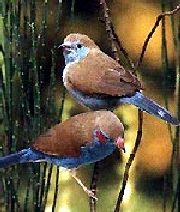BLUE CORDON

Scientific name: Uraeginthus bengalus
English name: Red-cheeked Cordon - bleu
The kind uraeginthus comprises some of devout beautiful the species of astrildidi present in our voliere and the blue Cordon, probably represents reperibile the common member devout and devout R-a.buon.mercato in commerce
DISTRIBUTION
East south of the Mauritania, Senegal and Gambia, Evils, northern part of the Ghana, leaves southern of the Niger, the Ciad and the Sudan, south of Ethiopia until the Uganda, western part of the Kenya, Cameroun, Republic Center African, Zaire and Rwanda
E' distributed in the greater part of Africa western center over the 1800 meters of height. In its lands of origin a bird much confidente becoming accustomed itself living in the vicinities of villages, parks and garden.
Description
E' a long bird around to 12,5 13 cm. The livery of unmistakable the adult male the cheeks, the advanced part of the chest and the flanks and the tail are of a beautiful one tonalit of blue, the advanced parts are tawny and ventre color the chamois. On the cheek beautiful shining red spot detaches one. The female lacks the red spot and devout the blue parts are less extend and than one tonalit faded.
The blue female of cordon easy confondibile with that one of the astrilde blue from which it only differs for the ransom and for the spout that introduces red the devout ones extended that in the cousins.
The young people are similar the females but they introduce the dark spout completely.
MAINTENANCE And FEEDING
As soon as imported it needs of warmth and cures in rather delicate how much but, once acclimatized it turns out peasant rather and very adapted to the life in cage. It needs ofone seed mixture of B type, verdura. Mangime the alive essential thing in order to maintain it in good health. Pu to be lodged in cages of 45 cm of length, but difficultly to reproduce themselves. If lodged in one cage at least 100 cm or in one voliera instead to reproduce itself ready.
COMPATIBILITA'
E' a not aggressive bird that pu to cohabit calmly with other species of astrildidi. In the same container devout males with in the age of the reproduction cannot in order to coexist.
SUGGESTED BREEDINGS by MENANDPETS.COM
No breeding to signal
if you want to know like signaling yours, contacts: marketing@inseparabile.it
REPRODUCTION
The dance of courtship of the male one of beautiful the devout shows to which pu to assist itself. Chosen a pagliuzza, firm in the point devout in sight of the cage and it is begun to sing swinging the head on and gi. The song much beautiful one and remembers that one of the allodola.
Times acclimatized a brace are reproduced enough easy. The nest constituted from a globular structure that constructed indifferently is in one cassettina to open facade that in a closed basket. If in the container always greens are available coppers prefer to construct former novo just the nest.
The brooded one comprises of usual 4-6 eggs white women who the female broods for approximately 12 days. To schiusa the parents they need of one large quantit of prede lives in order to raise the small. In absence case to eat alive the female scaraventa the small outside of the nest, as they make the greater part of the astrildidi, but it does not continue to heat them until their dead women Convene, perci, to entrust eggs to a reliable brace of hen-sparrows of Japan preventively accustomed to feed itself of a pastoncino highly proteico. To notice that the nidiacei of the sort uraeginthus ask the food without to raise the head, but swinging it of devious, perci only little braces of hen-sparrows of Japan are in a position to nourishing them the first days since.
E' necessary therefore to select these braces of sparrows and to of the sort reserve them exclusively to the breeding of the small of the members uraeginthus.
The small exit from the nest around to the 14 days of life and they are not still in a position to flying. Three weeks are independent after at least others.
we thank the breeding agate in order to have to us supplied this card